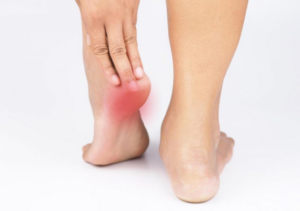Plantar fasciitis is a common foot condition characterized by inflammation of the plantar fascia, a thick band of tissue that connects the heel bone to the toes. This tissue supports the arch of the foot and acts like a shock-absorbing bowstring, helping to maintain the foot’s arch during walking.
Causes
- Overuse or Overloading: Repetitive stress or excessive pressure on the feet, often seen in runners, athletes, and individuals who stand for long periods.
- Foot Mechanics: Flat feet, high arches, or abnormal walking patterns (gait abnormalities) can strain the plantar fascia.
- Age: More common in middle-aged individuals.
- Obesity: Excess weight increases stress on the plantar fascia.
- Occupational Factors: Jobs that involve prolonged standing or walking on hard surfaces.

